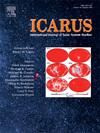Tectonic patterns on Vesta and Ceres revealed by polygonal impact craters
IF 2.5
2区 物理与天体物理
Q2 ASTRONOMY & ASTROPHYSICS
引用次数: 0
Abstract
Polygonal impact craters (PICs), impact craters with straight rims that form polygonal shapes in plan-view, form where pre-existing structures exist in the impact target rock. The straight rim segments of PICs and their preferred orientations are known to reveal hidden tectonic patterns that otherwise are invisible in spacecraft data. Vesta and Ceres are heavily cratered bodies that also experienced tectonics. We systematically mapped crater rims on Vesta and Ceres with crater diameters ≥ 10 and 20 km, respectively. We identified and extracted straight rim segments that maintain consistent orientations for at least 5 km to assess their segment lengths and orientations. The majority of mapped craters on Vesta and all craters on Ceres have at least one straight rim segment and thus are considered PICs. Analyses of straight rim segment orientations reveal multiple fracture sets that form complex but systematic regional and global patterns on both bodies. In particular, we detected an E–W trending fracture pattern in Vesta's north-polar region. Ceres predominantly shows NE–SW oriented fractures in the northern hemisphere and NW–SE oriented fractures in the southern hemisphere that are most pronounced at the poles. None of these patterns correlate with the orientations of large-scale troughs on Vesta and pit chains on Ceres or with large impact basins on Vesta, indicating that their origins are not directly linked. Their differing tectonic patterns indicate that different planetary processes controlled the formation of fractures responsible for the straight rim segments of the PICs. We compare our identified fracture patterns with predicted tectonic patterns caused by changes in spin rate, volume change, and true polar wander. However, predictions of tectonic patterns in the existing literature are not specific to, and thus not applicable to Vesta and Ceres, requiring more detailed modeling efforts and rock-mechanical reassessments to investigate the underlying processes that produced the fracture sets.
求助全文
约1分钟内获得全文
求助全文
来源期刊

Icarus
地学天文-天文与天体物理
CiteScore
6.30
自引率
18.80%
发文量
356
审稿时长
2-4 weeks
期刊介绍:
Icarus is devoted to the publication of original contributions in the field of Solar System studies. Manuscripts reporting the results of new research - observational, experimental, or theoretical - concerning the astronomy, geology, meteorology, physics, chemistry, biology, and other scientific aspects of our Solar System or extrasolar systems are welcome. The journal generally does not publish papers devoted exclusively to the Sun, the Earth, celestial mechanics, meteoritics, or astrophysics. Icarus does not publish papers that provide "improved" versions of Bode''s law, or other numerical relations, without a sound physical basis. Icarus does not publish meeting announcements or general notices. Reviews, historical papers, and manuscripts describing spacecraft instrumentation may be considered, but only with prior approval of the editor. An entire issue of the journal is occasionally devoted to a single subject, usually arising from a conference on the same topic. The language of publication is English. American or British usage is accepted, but not a mixture of these.
 求助内容:
求助内容: 应助结果提醒方式:
应助结果提醒方式:


